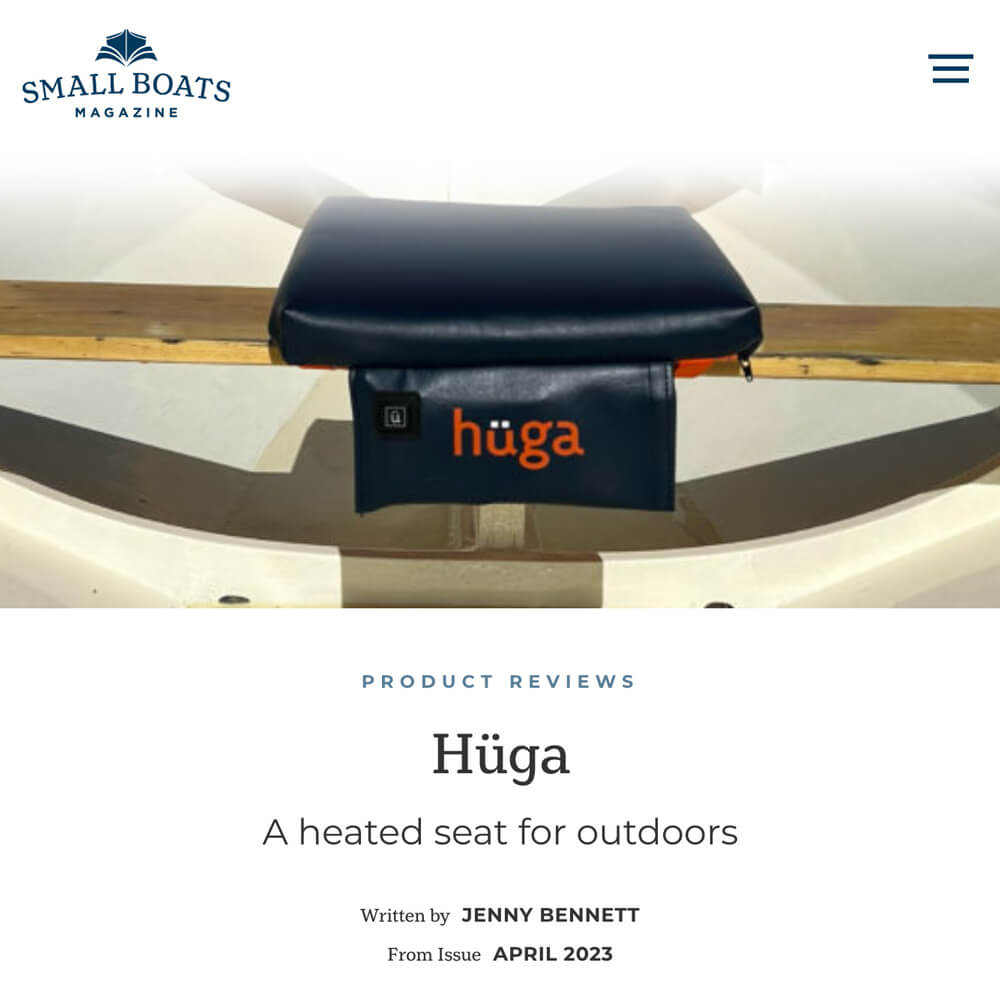We were honored to be featured in Small Boats Monthly
You can read the full article here

Excerpt below:
Living in Maine, where the winters are cold and long, I am ever on the hunt for new ways to keep warm, especially ones that will help to extend my boating season.The Hüga cushion, handsewn in Maine, comes from Hüga Heat. Owners Jocelyn Olsen and Colin Grieg describe it as “a smart seating solution that provides long-lasting, steady heat,” and sent me one to try.
The Hüga is a polyurethane-foam pad encased in removable water-resistant Cordura or marine-grade vinyl. Beneath the cover, on top of the foam, is a heating pad powered by a 22W, 16.75Ah battery. Complete with battery, the Hüga measures 16″ × 14″ × 2″ and weighs approximately 2 lbs. It comes in navy, two different greys, or white, and with a 3+hr, 6+hr, or 10+hr battery—the rating indicates the duration of the charge if the pad is kept at the highest temperature setting.
Out of the box my 6+hr battery had no charge. I plugged it in and after five hours, three of the four charge-indicator lights were illuminated. I left the battery plugged in overnight and had a full charge in the morning.
When ready to go, the battery slips into the Hüga’s pouch where it is plugged into a USB cable. The pouch is then closed with Velcro. For use around water, I would have liked an additional flap to come over the Velcroed opening to give the pouch and battery greater protection, and it might also be useful to have a transparent panel through which to see the charge level on the battery—for now, the only way to check the charge is to open the pouch and pull the battery out 1″ or so.
The Hüga Heat website notes that the Hüga gets up to between 105° and 120°F on the highest setting, 95–105° on medium, and 85–95° on low. The website also says that when exposed to the air—i.e., when no one is sitting on it—the cushion’s temperature will drop slightly. When I measured it with a digital kitchen thermometer, I recorded 116°F on the highest setting while sitting on it. I also wanted to test the longevity of the charge. Starting with the fully charged battery, I left the Hüga unattended on the hottest setting and it ran for 6-1⁄4 hours with no drop in temperature; it simply switched off when the battery charge ran out.
Next, I took the cushion out to our Shellback dinghy on a 40°F March afternoon. The Hüga is wider than the boat’s thwarts but once I had cinched the straps—1″-wide nylon webbing adjusted through snap buckles—it stayed put, was comfortable to sit on, and was a big improvement on a bare wooden thwart. For rowing, the additional height of about 1-1⁄2″ isn’t difficult to get used to, especially if you’ve already used a thick seating pad and you have enough clearance for the oar handles. I wasn’t out for long but even on a very cold day would probably use the cushion on its coolest setting and only raise it up to one of the higher settings if I stopped rowing for more than just a few minutes. For a serious rower, the thick, flat cushion may not be a good fit with a finely tuned rowing arrangement, but for a casual rower, or a passenger in the boat who isn’t getting the benefit of rowing to warm up, the heat from the Hüga would be welcome.
Back from the boat, I sat outside in a lawn chair. The air temperature was still about 40°F but now there was about a 10-knot breeze blowing. The heat from the cushion beneath me was wonderful and, after about 10 minutes, I felt too warm and reduced the setting from high to medium by pushing the button on the front of the pouch. There was no immediate sense of temperature change, but after a few minutes I was more comfortable—still warm, but no longer overheating. I sat for a while, taking notes, until my fingers became too cold and then, rather than reach for my gloves, I slid my hands beneath me and let the Hüga warm them.
I am perennially cold outdoors and the heat that comes from the Hüga is subtle but effective—it seeps into your body and lingers, warming you gradually so that you barely register it’s happening. It doesn’t give you the instant rush that can be gained from a roaring fire, but a more sustainable heat that would make sitting out on an open boat on a cold day or coming ashore on a late-season boat-camping trip, a much more comfortable experience—even for me.

